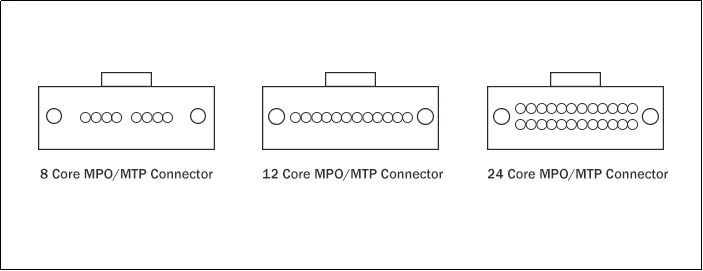

 Knowledge Base +
Knowledge Base +  2024.01.25
2024.01.25In the face of increasing demand for high-speed, high-capacity optical communication systems, MTP/MPO fiber optic connectors and fiber optic patch cords are the ideal solution to meet the demand for high-density cabling in data centers, which have multiple advantages such as high core count, small size, and high transmission rate.
What is MPO?
MPO fiber optic patch cable is a combination of MPO connectors and fiber optic cables, MPO connector type according to IEC 61754-7 there are several factors to distinguish between: the number of cores (fiber array number), male and female header (Male-Female), polarity (Key), polishing type (PC or APC). (PC or APC).
What core numbers are available for MPO?
Currently, MPO connectors are available in factory terminated assemblies that can accommodate from 6 to 144 fibers, with the more common being 12 and 24 core MPO connectors. According to IEC-61754-7 and EIA/TIA-604-5 (FOCIS 5) specification standards, 12-core fibers are usually arranged in a row, which can support one or more rows of fibers in the same MPO connector, depending on the number of cores discharged in the connector. Depending on the number of cores discharged in the connector, it is divided into one row (12 cores) and multiple rows (24 cores or more). 40G MPO-MPO fiber optic patch cords generally use 12-core MPO multimode inserts; 100G MPO-MPO fiber optic patch cords generally use 24-core MPO inserts. Currently, the market also has 16 single-row fiber array type, which can be divided into multiple rows to form 32 cores or more. 16/32-core MPO fiber optic connectors will become the best solution for low-latency, ultra-high-speed transmission of next-generation 400G networks.

MPO male and female connectors
MPO fiber optic connector contains optical fiber, sheath, coupling
assembly, metal ring, pin (PIN pin), dust cap, etc., of which the pin part is
divided into two forms: male header and female header. The male connector has
two PIN pins, while the female connector does not.The connection between MPO
connectors is through the PIN pins for precise alignment, the two MPO connectors
connected to each other must be a male and a female.
>>> Read More:What is the difference between a male and a female MPO fiber optic patch cable?
_1706175581.jpg)
MPO polarity classification:
Type A (straight-through type): The fiber cores of both ends of the jumper are arranged in the same position, i.e., 1 at one end corresponds to 1 at the other end, and 12 at one end corresponds to 12 at the other end, and the keys at both ends are oriented in the opposite direction, key up corresponds to key down.
_1706175610.jpg)
Type B (interleaved): The fiber cores on both ends of the jumper are arranged in opposite positions, i.e., 1 on one end corresponds to 12 on the other end, and 12 on one end corresponds to 1 on the other end; the key direction on both ends is the same, i.e., key up corresponds to key up, and key down corresponds to key down.
_1706175623.jpg)
Type C (interleaved pairs): Type C MPO patch cords have adjacent pairs of cores interleaved, i.e., core 1 at one end corresponds to core 2 at the other end, and core 12 at one end corresponds to core 11 at the other end, and the key direction of the keys at the two ends is also opposite, i.e., key up corresponds to key down.
_1706175646.jpg)
What is MTP?
MTP stands for "Multi-fiber Termination Push-on" and was developed by US Conec to improve the overall performance of the standard MPO connector with improved attenuation and reflection. Externally, there are few obvious differences between MPO and MTP connectors. In fact, they are fully compatible and mated with each other.
To summarize
Compared with ordinary fiber optic cables, the main features of MPO/MTP fiber optic cables are high density and pre-formed ends, which are ultimately embodied in MPO/MTP multi-core connectors. Throughout the development of the industry, fiber optic connectors have two distinct development stages: the first stage is to save space, to miniaturize the direction of the development of fiber optic connectors from the traditional FC, ST, SC to LC, MTRJ. the second stage is not only to save space, but also to meet the requirements of the use of multi-core, fiber optic connectors from the LC, MTRJ to the evolution of the MU, MPO / MTP. MPO / MTP Fiber optic connectors, fiber optic patch cords provide a simple and easy to manage fiber optic cabling solutions, widely used in the need for high-density integrated fiber optic lines FTTH and data centers, it is likely to become a hot demand for the construction of the future 5G data center products.
Additional Learning Hub Resources
In what ways does BiDi fiber enhance broadband transmission?
What is the difference between OS1 and OS2 SMF fiber optic cables?
What is an industrial grade optical module?
What is the difference between a silicon optical module and a regular optical
SC interface optical module some knowledge
Subscribe to the newsletter
for all the latest updates.
2-5# Building, Tongfuyu Industrial Zone, Aiqun Road, Shiyan Street, Baoan District, Shenzhen. China
